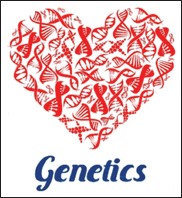INTRODUCTION
Coronary artery disease (CAD) is the leading global cause of mortality.[1] Known risks to its development are lifestyle choices, age, sex, and inherited genetic variants. An international research team (the CARDioGRAM and the Coronary Artery Disease Genetics Consortia) has confirmed ten previously identified markers associated with heart disease and uncovered 13 new genetic markers that increase heart disease risk.[2]
Understanding how these genes work will vastly improve our knowledge of how the disease develops which could ultimately lead to new forms of treatments.
A BRIEF HISTORY
Gregor Mendel is known as the “Father of Genetics.” He died in 1884, but his experiments with the pea plant in his monastery revolutionized genetics. He was a priest in the Catholic Church and lived in a monastery. He was also a scientist.

Gregor Mendel
Through his work on pea plants, Gregor Mendel discovered the fundamental laws of inheritance. He realized that genes come in pairs and are inherited as distinct units, one from each parent. Mendel tracked the segregation of parental genes and their appearance in the offspring as dominant or recessive traits. He recognized the mathematical patterns of inheritance from one generation to the next.[3]
Mendel used seven pea plant traits in his experiments which included flower color (purple or white), flower position (axil or terminal), stem length (long or short), seed shape (round or wrinkled), seed color (yellow or green), pod shape (inflated or constricted), and pod color (yellow or green).[4]
The genetic experiments Mendel did with pea plants took him 8 years (1856–1863), and he published his results in 1865. During this time, Mendel grew over 10,000 pea plants, keeping track of progeny number and type. Mendel's work and his laws of inheritance were not appreciated in his time. It was not until 1900, after the rediscovery of his laws, that his experimental results were understood.[4]
In the 20th century, there was renewed interest on biology – how traits and characters were transmitted. In particular, there was a growth of eugenics – a movement that aimed to improve the genetic composition of the human race by selective breeding and focused public attention on heredity.[5] There was renewed interest in Mendel's pea plant experiments as it was initially thought to help scientists explain heredity. The term “genetics” was coined by W. Bateson in 1905.[5]
His experiments showed that the inheritance of certain traits in pea plants follows particular patterns, subsequently becoming the foundation of modern genetics and leading to the study of heredity.[6]
FAMILY HISTORY AND CARDIOVASCULAR DISEASE
Genetics can influence the risk for heart disease. A family history of cardiovascular disease (CVD) modifies future risk of CVD depending on the number and age of affected first-degree relatives.[7]
Many cardiac disorders can be inherited, including arrhythmias, congenital heart disease, cardiomyopathy, and high blood cholesterol. CAD leading to heart attack, stroke, and heart failure can run in families. A genetic variation (mutation) in a single gene can affect the likelihood of developing heart disease. Genetic variations are passed from parents to children in the DNA of the eggs and sperm. The parents' genetic code is then copied into every cell of a child's body during development.[8]

In the Framingham study, there were 2302 male and female offspring study participants with a parental history of premature CVD (fathers <55 years and mothers <65 years) and they were analyzed for CVD risk. After 8 years of follow-up, CVD increased 75% with paternal and about 60% with a maternal history of premature CVD. The Framingham study found also that CVD increased about 40% in those whose siblings had CVD.[9]
In identical twins, the hazard ratio of death from CAD increased 3.8–15 times if an identical sibling died of CAD before the age of 75 and risk was 3 times higher for identical than for nonidentical twins.[9]
After 16 years of a follow-up study, the Framingham study also found that a family history of premature CAD (age <50 years) conferred a 44% increased risk of CVD mortality. A large international case-control study[5] found an increased risk of myocardial infarction (MI) if (1) one parent had MI (odds ratio [OR] = 1.67), (2) one parent had MI before the age of 50 (OR = 2.36), (3) both parents had MI (OR = 2.90), and (4) both parents had MI before the age of 50 (OR = 6.56). The results were similar when adjusted for CVD risk factors across socioeconomic status of household or country and for maternal or paternal MI history.
CONCLUSIONS
Genetics – although complex – can influence the cardiovascular system in profound ways and affect many of our cardiac risk factors. Family history can be as strong an indicator of heart disease as high blood pressure or high cholesterol levels. However, family history is more than DNA. A family shares a lifestyle and home environment. For example, growing up in a household of smokers or a family that ate a steady diet of fast-food meals can influence blood pressure and cholesterol levels. Environmental factors such as air pollution, poor water, and food quality and chemicals such as carbon monoxide can contribute to the development of heart disease.
It is likely that people with a family history of heart disease share common environments and other factors that may increase the risk of CVD. In fact, as the Framingham study proved, unlucky genes can double or triple the risk of heart disease. However, genes do not act alone – lifestyle, diet, and exercise modify the risk of CVD. These factors are more important than simply having a genetic makeup that predisposes one to heart disease.
The risk for heart disease can increase even more when heredity combines with unhealthy lifestyle choices, such as smoking cigarettes and eating an unhealthy diet.
Financial support and sponsorship
Nil.
Conflicts of interest
There are no conflicts of interest.
REFERENCES
- 1.Khera AV, Kathiresan S. Genetics of coronary artery disease: Discovery, biology and clinical translation. Nat Rev Genet. 2017;18:331–44. doi: 10.1038/nrg.2016.160. [DOI] [PMC free article] [PubMed] [Google Scholar]
- 2. [Last accessed on 2019 Dec 15]. Available from: https://www.bionews.org.uk/page_92873#:~:targetText=An%20international%20research%20consortium%20has, of%20heart%20attacks%20and%20strokes .
- 3. [Last accessed on 2019 Dec 15]. Available from: http://www.dnaftb.org/1/bio.html .
- 4. [Last accessed on 2019 Dec 15]. Available from: https://www.livescience.com/7537-monk-peas-changed-world.html .
- 5. [Last accessed on 2019 Dec 15]. Available from: https://en.wikipedia.org/wiki/Eugenics .
- 6. [Last accessed on 2019 Dec 16]. Available from: https://sites.google.com/a/wisc.edu/ils202fall11/home/student-wikis/group 8 .
- 7.Kolber MR, Scrimshaw C. Family history of cardiovascular disease. Can Fam Physician. 2014;60:1016. [PMC free article] [PubMed] [Google Scholar]
- 8. [Last accessed on 2019 Dec 16]. Available from: https://www.ottawaheart.ca/heart-condition/inherited-cardiac-conditions-genetic-disorders .
- 9.Lloyd-Jones DM, Nam BH, D'Agostino RB, Sr, Levy D, Murabito JM, Wang TJ, et al. Parental cardiovascular disease as a risk factor for cardiovascular disease in middle-aged adults: A prospective study of parents and offspring. JAMA. 2004;291:2204–11. doi: 10.1001/jama.291.18.2204. [DOI] [PubMed] [Google Scholar]


